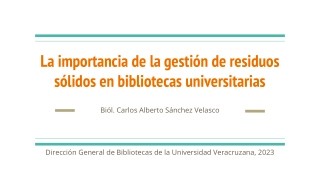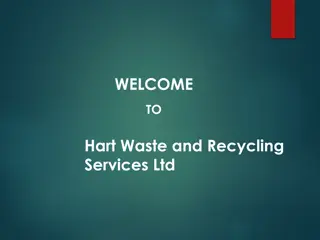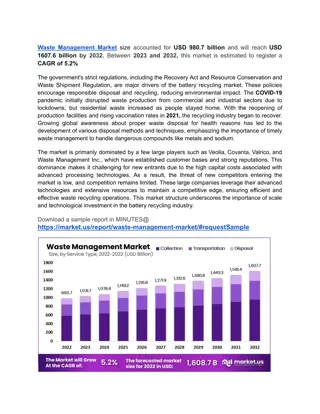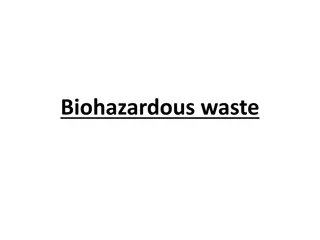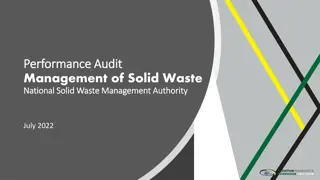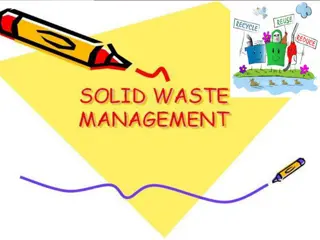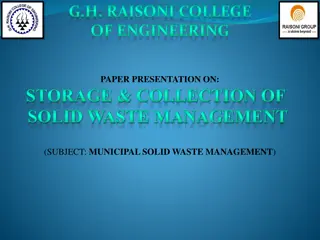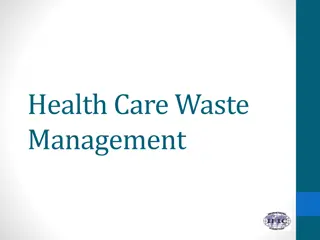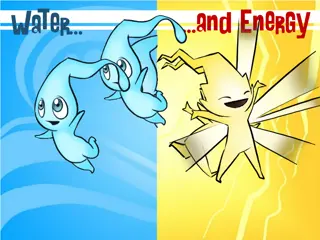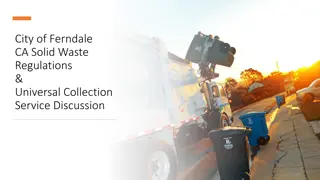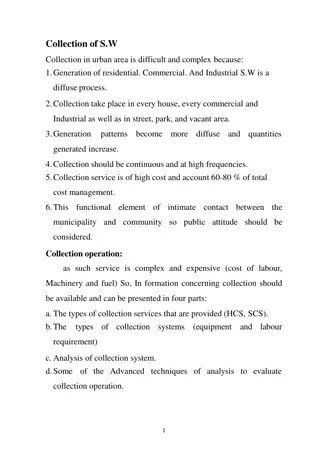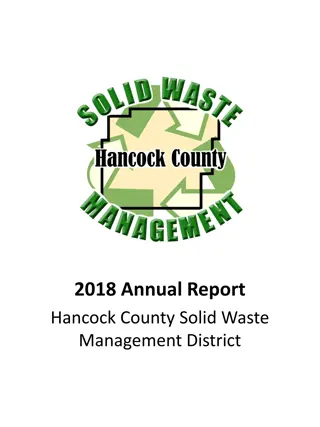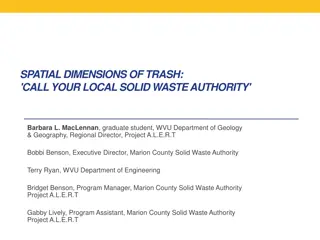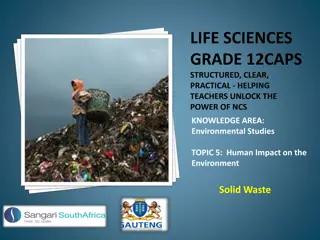Understanding Solid Waste Management and Its Importance
Waste management includes the collection and treatment of solid waste to protect the environment. Waste is seen as a resource, with categories such as municipal and industrial waste. Proper waste management is crucial to prevent pollution and disease outbreaks. Principles include an integrated approach, transparency, and considering real costs.
Download Presentation

Please find below an Image/Link to download the presentation.
The content on the website is provided AS IS for your information and personal use only. It may not be sold, licensed, or shared on other websites without obtaining consent from the author. Download presentation by click this link. If you encounter any issues during the download, it is possible that the publisher has removed the file from their server.
E N D
Presentation Transcript
INTRODUCTION Waste is everyone s business as we all produce waste in nearly everything we do. Solid waste is any unwanted or discarded material that is not liquid or gas OR any discarded, rejected and unwanted or abandoned matter. Modern view of looking at waste is that there us nothing waste in this world and that waste is a resource. (resource is anything obtained from living and non living environment to meet human needs and wants) or garbage is gold.
CATEGORIES OF SOLID WASTE Solid waste can be broadly categorized as: a) Municipal solid waste: The discarded materials, substances or objects which originates from domestic, business and various institutions which are typically disposed of in municipal type landfill (which is controlled site for the deposition of solid waste on land) b) Industrial Solid Waste: Solid industries. ANOTHER useful distinction is between a) Hazardous Waste: Solid, liquid or gaseous wastes which have properties that could pose dangers to human health, property, or the environment if they are not properly treated, stored, transported and disposed of or otherwise properly managed. Without limiting this definition waste is considered hazardous if it is ignitable, radioactive and includes healthcare, chemical and related wastes. waste sourced from manufacturing corrosive, reactive, toxic or
CATEGORIES OF SOLID WASTE b) Non-hazardous waste: Waste which do not possess any of the above referred properties and includes household waste, green waste (garden waste and other waste suitable for composting) SIMILARLY distinction can be made between: a) Organic waste: Waste comprising of animal or vegetal matter and typically from which compost can be produced. b) Inorganic waste: Waste which is not liable to become putrid decomposed or rotten
SOLID WASTE MANAGEMENT Solid waste management is a term that is used to refer to the process of collecting and treating solid wastes. It also offers solutions for recycling items that do not belong to garbage or trash. It is the control of waste related activities with the aim of protecting the environment and conserving resources. According to Britannica, Solid-waste collecting, treating, and disposing of solid material that is discarded because it has served its purpose or is no longer useful. Improper disposal of municipal solid waste can create unsanitary conditions, and these conditions in turn can lead to pollution of the environment and to outbreaks of vector-borne disease that is, diseases spread by rodents and insects. management, the
Principles of Solid Waste Management Integrated approach to solid waste management Ensure transparency in the system Consider real (economic, environmental and social ) costs Adopt participatory approaches Education/ Consultation Consistency with legal provisions
Elements of Solid Waste Management Generation: It encompasses activities in which material are identified as no longer being in value, i.e. Materials that are thrown away for disposal. Storage: Involves activities associated with management of waste until it is placed in storage containers for collection. Collection: It involves gatherings as well as transport of these materials after collection to the location where collection vehicle is emptied. Transfer and Transport: The functional element of transfer and transport involves two types: (i) The transfer of waste from the smaller collection vehicle to the larger transport equipment and (ii) The subsequent transport of the waste, usually over long distances, to processing or disposal site. Processing and Transformation: (i) It involves recovery of sorted material, processing of sorted waste and its transformation in location away from the source of waste generation. (ii) It helps to recover conversion products and energy while transformation is taking place. Disposal: It involves disposal from land filling and uncontrolled dumping collected from residential, commercial and industrial areas.
Strategies for Waste Management Reduce (minimize the quantity of waste produced) o E.g. source reduction prevents products or by otherwise changing societal patterns of consumption and waste generation) Reuse (use of an item more than once e.g. shopping bags, old books, white board markers) or repeated use of a waste material in a process (often after some treatment or makeup) Recycling (the reprocessing material into new or different products) o Recyclable materials include many kinds of glass, paper, metals, plastics, textiles and electronics) waste either by redesigning or remanufacturing of
Strategies for Waste Management Biologically Treat Waste (e.g. decomposition of organic waste to form compost) Incinerate Waste (waste is burnt n high incineration furnace to ashes) Bury Waste in state of the art landfills Waste Recovery o Extraction from a waste of some materials or components that have value in other uses (e.g. salvage of leas from car batteries, copper wire from old fan) o Extraction and utilization of energy from waste stream E.g. Bio gas made from slurry of cow dung and water Use of refuse derived fuel (dried recyclables) for use in cement plants, power generation plants etc.) and shredded municipal; waste excluding
Considerations for Landfill Sites Solid waste should be properly disposed off in well planned landfills. Land fillings should be restricted to: o No biodegradable (Waste which can not rot and change into manure like soaps, synthetic cloth/rubber, fiber glass, nylon or other plastic substances.) o Inert Waste (Waste which is neither chemically nor biologically reactive and will not decompose. Examples of this are sand, concrete, grit, demolition/construction waste) and o Other waste (E.g. waste arising from road construction, ash, dust etc.) that are not suitable either for recycling or for biological processing.
Considerations for Landfill Sites Land filling of mixed waste (hazardous with municipal) should be avoided. Landfill sites should meet as far as possible the following key location criteria: o Adequate land area and volume to provide the landfill capacity to meet projected needs for at least twenty investments in access roads, drainage, fencing and weighing stations are justifiable. o Land areas should not be in areas where adequate buffer zones are not possible or near residential areas in prevailing wind direction. o Areas should not be characterized by steep gradients where stability of slopes could be problematic. five years, so that costly
Considerations for Landfill Sites Seasonally high water table level (i.e. 10 years high) of the groundwater should be below (atleast 5-10 ft.) for proposed base of excavation or site preparation for landfill development. No environmentally significant biodiversity, sensitive ecological/ or historic areas should be present within atleast a distance of 500 to 3000 m. Areas should not be in close proximity water bodies, e.g. watercourses or dams (these should be atleast be at 300 to 1000 meters distance) o wetlands of important o to significant surface o
Considerations for Landfill Sites No major lines of electrical transmission or other infrastructure should be crossing the landfill development area. No residential development should be adjacent to the perimeter of the sites boundary. The waste disposal site should be at least outside a radius of 1000 meters away from residential or commercial area. Landscaping and protective berms should be incorporated into the design to minimize visibility of operations from residential neighborhoods. Unstable areas are not recommended- i.e. there should not be any significant seismic risk within the region of the landfill. o o o o
Considerations for Landfill Sites A buffer zone of no development should be maintained around landfill site and should be incorporated municipality's land use plans. Landfill site should be away from airports. Necessary approval of airport or airbase authorities like Civil Aviation Authorities the Government of Pakistan prior to the setting up of the landfill site should be obtained in the cases where the site is located within 10km of an airport. o in the concerned o of
Solid Waste Management in Pakistan Solid waste management situation in Pakistan is a matter of grave concern as more than 5 million people to die each year due to waste-related diseases. In Pakistan roughly 20 million tons of solid waste is generated annually, with annual growth rate of about 2.4 percent. Karachi, largest city in the country, generates more than 9,000 tons of municipal waste daily. All major cities, be it Islamabad, Lahore or Peshawar, are facing enormous challenges in tackling the problem of urban waste. The root factors for the worsening garbage problem in Pakistan are lack of urban planning, outdated infrastructure, lack of public awareness.
Solid Waste Management in Pakistan More waste is being produced in the country than the number of facilities available to manage it. Some of the major problems are: There is no proper waste collection system Waste is dumped on the streets Different types of waste are not collected separately There are no controlled sanitary landfill sites. Opening burning is common. Citizens are not aware of the relationship between reckless waste disposal and resulting environmental and public health problems As a result of these problems, waste is accumulating and building up on roadsides, canals, and other common environmental health. The waste on the roads effects overall environment and human health. Poor SWM in Pakistan has caused numerous diseases and environmental problems to rise. areas threatening human and
Case of Lahore There are currently no controlled waste disposal facilities or formal recycling systems available in Lahore. Though roughly 27% of waste (by weight) is recycled through the informal sector, but Lahore governmental management in this regard. The City District Government Lahore established The Lahore Waste Management Company responsibility for solid waste management. Beginning in 2011, LWMC strived to develop a system of SWM that ensures productive collection, recovery, transportation, treatment and disposal of the waste in Lahore. lacks high performing (LWMC) and gave them
Case of Lahore LWMC has over 10,000 field workers involved in waste collection and disposal. Though the LWMC is working in phases, 100% collection rates are not seen yet. Lahore currently has only three disposal sites which are no more than dumps, where illegal dumping and trash burning is common. Additionally, in November 2013 a German company, agreed to invest in the installation of a 100 megawatt power plant which generates energy from waste from Lahore. Progress is being made on the country s first scientific waste disposal site in Lakhodair. With this in mind, the Lahore Waste Management Company considered other possible technologies for their Waste-to- Energy project.
The Way Forward Although implemented and enforced lack as a result of the governmental institutions lacking resources and equipment. These institutions are primarily led by public sector workers and politicians who are not necessarily the most informed on waste management. For improvements in municipal necessary for experts to become environmental governance. Due to the multiple factors contributing accumulation, the problem has become so large it is beyond the capacity of municipalities. SWM policies do exist, the levels at which they are solid waste involved management, and assist it is in the to the solid waste
The Way Forward The former director of the Pakistan Council of Scientific and Industrial Research, Dr. Mirza Arshad Ali Beg, municipal solid waste disposal system in Pakistan cannot be attributed to the absence of an appropriate technology for disposal but to the fact that the system has a lot of responsibility but no authority. Laws and enforcement need to be responsibility for future change is in the hands of both the government, and the citizens. Waste practices in the Pakistan need to be improved. This can start with awareness to the public of the health and environment impacts that dumped and exposed waste causes. It is imperative for the greater public to become environmentally educated, have a change in attitude and take action. stated, The highly mismanaged revised and implemented. The



